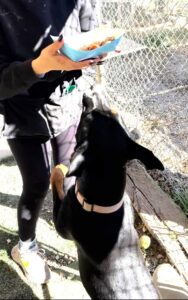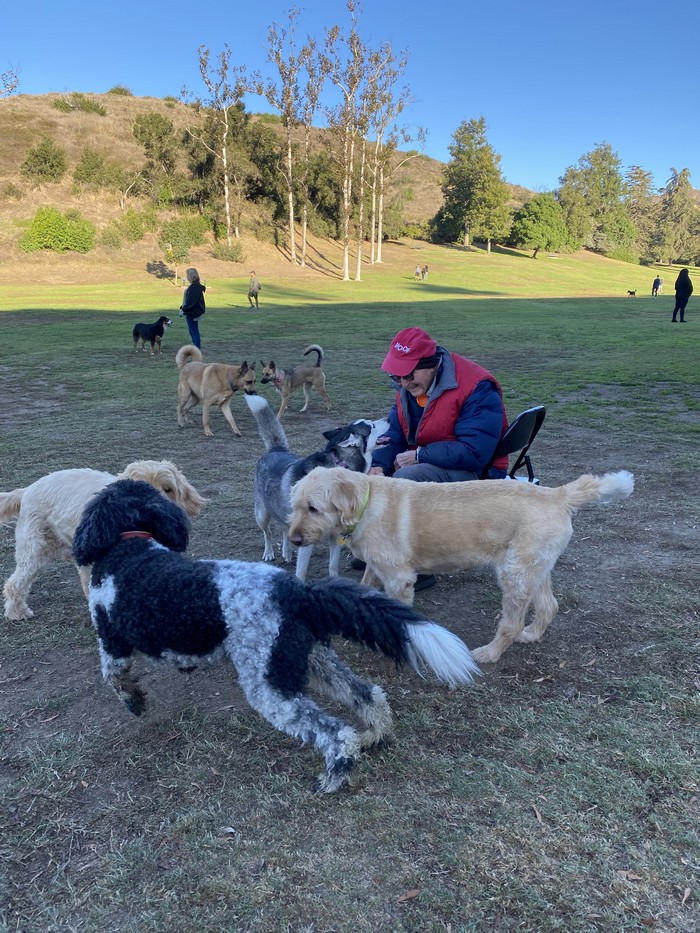 •Adoptable dogs receive Thanksgiving dinner from volunteers
•Adoptable dogs receive Thanksgiving dinner from volunteers
More than 70 dogs available for adoption through All for Love Animal Rescue (AFLAR) and Canine Adoption and Rescue League (C.A.R.L.) received homemade Thanksgiving meals, complete with turkey, mashed potatoes, vegetables and canine-appropriate pumpkin pie this Thanksgiving.

“I wanted to give something back to these organizations and the dogs they have rescued and provided care and shelter to. I thought to myself, ‘Let’s make Thanksgiving dinner for our pups.’ Thankfully, several of my fellow volunteers went along with the idea and gathered at my house the evening before Thanksgiving,” said AFLAR volunteer, Lupe Flores.
“We are very grateful for these meals that our volunteers cooked and assembled for all the dogs,” stated AFLAR Founder and President Maripat Davis. “Volunteers are the heart of AFLAR, and we are always in need of new volunteers and fosters and donations to help us continue our life-saving work.”
Both AFLAR and C.A.R.L. are counting on other community members to support their organizations this holiday giving season.
“As a boarding facility that rescues hundreds of dogs each year, we’re always in need of assistance, whether it’s through giving monetary donations, fundraising, volunteering or donating food and supplies through Amazon Smile,” said Clark.
Shelters nationwide are overcrowded as many Americans cannot afford to own their pets. A recent report highlights that public and private shelters across the nation are expected to reach a three-year high in euthanasia rates in 2023. For example, around 51,000 dogs were euthanized during the first half of the year representing a nearly 40% increase from that same period in 2022.
In addition, pet-friendly affordable housing seems to be one of the most common issues when people surrender their dogs, particularly large dogs, followed by the cost of veterinary care.
“Our organizations relentlessly work to find long-term foster and forever homes for our dogs in addition to providing them with necessary medical care and training,” Clark said.
AFLAR boards its rescued dogs at the C.A.R.L. facility in Santa Paula and also has several adoptable dogs in foster homes. Davis says she constantly receives emails and phone calls from pet owners who can no longer care for their dogs but want to rehome them.
“There is a crisis in our nation with regard to shelter overcrowding. We work non-stop to save as many lives as we can,” said Davis. “That’s why we need ongoing support!”
Please consider giving your support to C.A.R.L. and AFLAR this holiday season. You can donate to C.A.R.L. and AFLAR or reach out to these organizations and sign up to volunteer. Both organizations rely on volunteers and donations and do not receive government, state or city funding.
All For Love Animal Rescue, Inc. (AFLAR) is a 501(c)(3) nonprofit all-volunteer animal rescue group, dedicated to saving abandoned animals from shelters in Southern California. We are an all-breed rescue but focus on dogs in the most need, primarily Pit Bulls, followed by seniors, Chihuahuas, pregnant dogs and those needing medical care or surgery. We rescue, rehabilitate, and find forever homes through adoption events, networking, and community outreach.
Canine Adoption and Rescue League (C.A.R.L.) is a 501(c)(3) non-profit all breed, no-kill dog rescue and adoption organization. Since 1996, C.A.R.L. has rescued and placed thousands of unwanted, sick, abandoned and homeless dogs. Dogs in our adoption program are placed in pre-screened, loving and secure homes. We make a lifetime commitment to all of our dogs.
•Trainer shares the secret to getting your dog to ignore other dogs and focus on you — and it’s so simple!
By Kathryn Williams
Want your dog to learn that you’re the most important thing in their environment? This trainer’s clever tip will do it…
We’ve all been there — you let your dog off leash thinking they’ll stick close to your side, and before you know it they’ve sprinted off into the distance to greet another pup!
If you try to call your fur friend back in these situations and aren’t successful, there could be many reasons why your dog’s recall isn’t reliable.
But rather than trying to fight to get your dog to come back to you, it’s best to arm yourself with the best puppy toys and treats and use these as your secret weapon to prevent them from running off in the first place.
“It’s not difficult to teach your dog not to run over to other dogs,” says Spivey.
“The mistake people make is they take the dog out and because it’s friendly they let it off the leash and then it just runs over to the other dog.”
Spivey says that in that moment the dog learns not only that you can’t stop it, but that the other dog or person it’s running over to may be more exciting than you.
Mila starts to position her body in the direction of her potential new friend, but Spivey gently waves a tug toy in front of her face and she quickly moves back towards him to play.
“By not allowing the dog to make those bad choices and having something positive for the dog to play with, very quickly the dog doesn’t care about other dogs,” explains Spivey.
This simple method of replacing what’s captured your dog’s attention with something that’s even more high-value will teach them that you are more interesting than anything else in their environment.
So next time your dog shows an interest in another dog or person, why not try bringing their focus back to you with a toy or treat?
You may just find it turns out to be one of the best ways to have more fun with your dog on walks!






